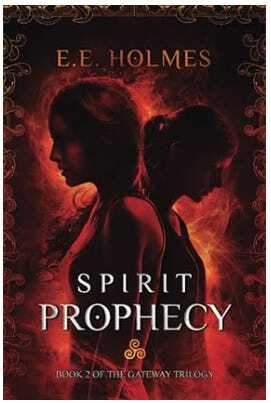One theme the Gateway Trilogy possesses will make it a favorite among libertarians

Now that my life seems in order, the time’s come for deeper dives. And trust me, Month 1 of 2025 was outright chaos, but not in a bad way. The good news is that I finally have some sacred reading time carved out, meaning I’m making leaps and bounds with E.E. Holmes’ Spirit Prophecy.
This is a book I’ve continually said libertarians will love, as I’ve mentioned in previous pieces. That said, I highly doubt Holmes is a libertarian but that doesn’t mean we can’t dig deep and find some themes that match the philosophy. In this case, we don’t need to dig deep at all.
The Libertarian Book Reviewer is a reader-supported publication. To receive new posts and support my work, consider becoming a free or paid subscriber.
Early in the book, there’s a chapter called Gender Politics, and if you’re anything like me, it’s a section that piqued my interest. Well, these days, not so much, because the scene in which we meet Fiona, Jess Ballard’s mentor, is literally just a few away, and Fiona’s my favorite character besides Hannah.
The woman is a complete lunatic, almost a mixture between Severus Snape (the book version) from Harry Potter and Doc from Back to the Future if you want a quick take on her personality. Anyway, flashing back to Chapter 5, we get the inside scoop on the Durupinen (duruh-pine-in) and their relationship with the Caomhnoir (keev-noor).
It’s also the scene when we meet Finn Carey, another favorite of mine. He quickly becomes the book’s most complex character within a single scene, might I add. And a lot of it has to do with the turbulent and at best, cordial, relationship between the Gateway (Durupinen) and their Protectors (Caomhnoir).
A foreshadowing tale of what makes central planning awfulIn the scene, we notice what’s called a Sanctity Line. On one side of it, the Durupinen sit and on the other side, the Caomhnoir. Then, Mackie, one of the few Durupinen Apprentices who is friendly toward Jess and Hannah, explains why the Sanctity Line is there, and that it’s symbolic of keeping the Durupinen and Caomhnoir separate, or pure.
This becomes a major talking point throughout the book, especially since Jess doesn’t like the idea of having a male protector. She sees the Durupinen as stuck in their ways, and she’s right. Very, very right. But even she doesn’t know how right she is.
See, the Durupinen go as far as to forbid their Sisterhood to get romantic with the Caomhnoir, and there are strict punishments for those who break that rule. We find out later why that is, and since this one’s full of fantasy genre tropes, you can guess it has something to do with Jess and Hannah.
This is where the work foreshadows and even provides insight into our own world of why central planning, regardless of your feelings toward it and how successful it may look on the surface, is destined to fail.
Central planning and fear-based policies get destructiveClimaxes in every book out there should have one goal: Provide such an adrenaline-pumping experience that, no matter how often you read that book, you can’t stop turning the page.
Thanks for reading The Libertarian Book Reviewer! This post is public so feel free to share it.
Hey, I’ve read Spirit Prophecy twice in e-book form, listened to it at least once, and now I’m reading it in paperback. I’m gonna tell you this: I’m 1,000 percent sure the paperback experience will be every bit as adrenaline-pumping as the e-book and audiobook.
Throughout this dark tale, Jess gains a lot of insights on just how far (most of) the Council will go in using fear-based policymaking and central planning to try and stop a doomsday prophecy from coming to pass.
I’m sure you can guess that it doesn’t turn out well for the Durupinen. Instead of stepping back and allowing others to study the prophecy closely and knowing the signs of when it would come to pass that would have prevented catastrophe, the Durupinen, and more notoriously their Council, engaged in constant fear-mongering, jailed, and even killed to keep their Sisterhood from facing the inevitable.
A shortlist of the Durupinen’s brutality amidst central planningThey lied to the Caomhnoir and claimed the Durupinen were temptresses. To measure a Caomnhoir’s “manliness,” he had to resist the Durupinen’s supposed “lure” that didn’t exist.
You’ll find out that Durupinen Apprentices may have different gifts beyond just seeing and interacting with spirits. For example, Jess is a Muse. Mackie is an Empath. But there’s one gift, thanks to the Durupinen’s “Doomsday Prophecy,” that the Sisterhood fears, and that gift is a Caller. One who can summon spirits to do their bidding.
Anyway, the Durupinen had a history of going as far as to detain Callers and render them ‘guilty until proven innocent’ that they weren’t the Caller foretold in the prophecy. In the book Spirit Ascendency, it’s revealed that this caused one Caller to side with and spy for the Durupinen’s longtime nemesis (and even darker) organization, the Necromancers.
You could probably also predict that this Caller was more than willing to wreak havoc on the Sisterhood that betrayed her trust. But it gets even better because, as you’ll discover in Spirit Prophecy, one daughter of an “illegitimate” relationship between a Durupinen and a Caomhnoir was brutally murdered by the Durupinen.
Getting to the book’s climax, the Durupinen have Jess and Hannah on trial. Because 1) they’re twins (also foretold in the prophecy), and 2) Hannah is that Caller - but she’s not the one who betrays the Durupinen, just an FYI.
Still, the Durupinen have Jess and Hannah in a ‘guilty as-charged’ situation. While the reader won’t learn about who Jess and Hannah’s dad is until Spirit Ascendency, the Durupinen believe, without evidence at this point, they’re the twins and Hannah’s the Caller mentioned in that prophecy.
But this was all to keep the Sisterhood safe, right?It depends on what your idea of ‘keeping people safe’ looks like. But even if central planning kept people safe 100 percent of the time, the fact that the principle of force is involved violates the basic human right to self-ownership, rendering it null.
As for the Gateway Trilogy, the Durupinen’s central planning may have put on the facade that it kept people safe, but does that justify murdering a young girl because of her bloodlines? Does it justify criminalizing their own people because they happen to be Callers?
And does it justify lying to a group of Protectors to keep their bloodlines “pure” from those Durupinen temptresses? Hey, most of the Council has blood and lies all over their hands. And Holmes makes it clear in Spirit Ascendency and the sequel series the Gateway Trackers, that all this central planning nearly led to the Sisterhood’s downfall.
Rather than keep the Durupinen Sisterhood safe, it merely spewed distrust between them and the Caomhnoir. Distrust also spawned between the Durupinen and anyone who happened to be a Caller. And that’s just the tip of an even larger iceberg.

As I make it clear in my upcoming young adult fantasy series, Arcane Elemental Academy, central planning only stifles and doesn’t spur growth or creativity. Yote Diamondback had spent years subjected to a heavily regulated school curriculum until she attended Arcane. And you can join her on the adventure before the adventure takes place by checking out my free novella, Arcane Awakenings.



